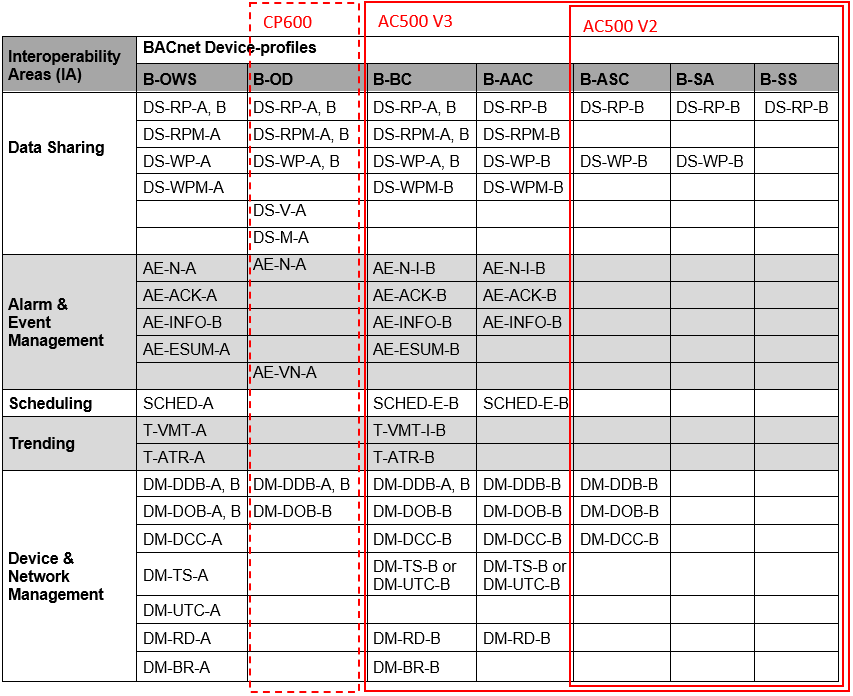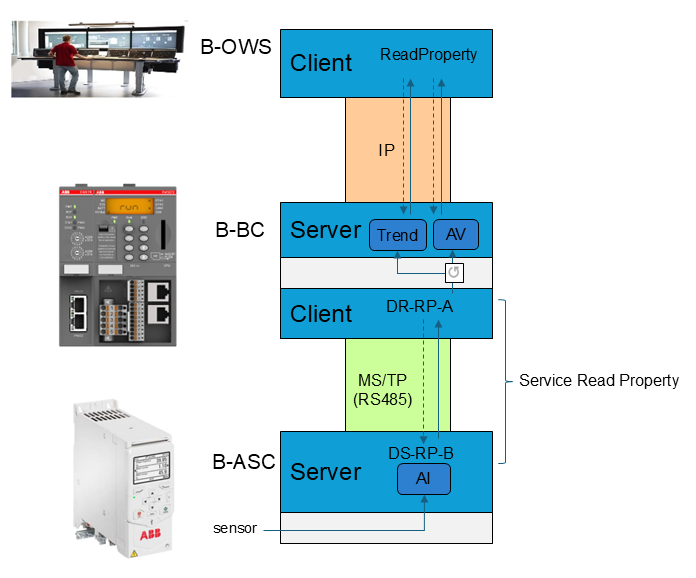A BACnet device can be described by its “BACnet Interoperability Building Blocks” (BIBB)s, which are needed to establish services. They are grouped in different areas:
-
“Data Sharing” (DS)
-
“Alarm and Event Management”(AE)
-
“Scheduling” (SCHED)
-
“Trending” (T)
-
“Device and Network Management” (DM)
“Data Sharing” for example contains two BIBBs which are needed for the “Service Read Property”:
-
Client side: DS-RP-A (Data Sharing - Read Property - A)
-
Server side: DS-RP-B (Data Sharing - Read Property - B)
The BACnet standard defines profiles by the minimum required BIBBs, see table below. “BACnet Simple Sensor” (B-SS) is the simplest one, only containing one BIBB. More complex devices contain more BIBBs (from right to left).

The AC500 V2 supports BIBBs qualifying it as “BACnet Application Specific Controller” (B-ASC), by installing the BACnet B-ASC library.
AC500 V3 supports many more BIBBs qualifying it as “BACnet Building Controller” (B-BC), which contains a server (all BIBBs ending with -B) and a client (all BIBBs ending with -A). In fact, the AC500 contains some more BIBBs. All BIBBs under B-BC in the table above, plus:
|
DS-COV-A, -B |
(Change of Value-A, -B) |
|
DS-COVP-A, -B |
(Change of Value of Properties-A, -B) |
|
AE-N-E-B |
(Alarm and Event-Notification External-B) |
|
AE-ASUM-B |
(Alarm and Event-Alarm Summary-B) |
|
SCHED-I-B |
(Scheduling-Internal-B) |
|
T-VMT-E-B |
(Viewing and Modifying Trends External-B) |
|
DM-TS-B |
(Time Synchronization-B) |
|
DM-UTC-B |
(UTC Time Synchronization-B) |
|
DM-MTS-A |
(Manual Time Synchronization-A) |
|
DM-LM-B |
(List Manipulation-B) |
|
DM-OCD-B |
(Object Creation and Deletion-B) |
|
NM-BBMDC-B |
(BBMD Configuration-B) |
|
... |
A list with all details can be found in the Automation Builder pdf document ABB-B-BC-PICS-AC500_V3.pdf. Direction: Help/Project examples/Examples.

A drive with several actuators and sensors is acting as B-ASC, for example providing a temperature value as “Analog Input” (AI) object on the MS/TP network.
⮫ “Supported BACnet networks ”
AC500 B-BC as client can read this temperature value, perform some processing (scaling, limit check) and on the server side provide the processed value as “Analog Value” (AV) object and as “Trend” object on the IP network. Higher level clients like BACnet Operator Workstation (B-OWS) can access the processed objects “Analog Value” and “Trend” for supervision.
The following chapters describe the possible applications and how to configure a PLC as B-BC.






